Volumetric paintings on asphalt and walls of houses have long been part of modern fine art. For beginners mastering the technique of 3D drawing, ordinary paper will do.
Rules for drawing 3D drawings on paper
A sheet is characterized by two dimensions - length and width. To give depth and volume to an image drawn on this flat surface, you need to understand what linear perspective, light and shade and foreshortening are. It is difficult to create the appearance of a third dimension in a drawing without taking into account the position of the depicted object in space in relation to the viewer.
To create the illusion of volume in modern art, the effect of anamorphosis is often used - a distortion of the projection of an image, which becomes proportional at a certain viewing angle. However, this is not a new technique. A good example of perspective anamorphosis is the skull in the painting "The Ambassadors", painted in 1533 by the German artist Hans Holbein.
Contemporary Italian artist Alessandro Diddi uses anamorphosis in his works.
He adds real objects to the photos with his drawings - a pencil, an eraser or his own hand, which makes the pictures even more realistic.To see the shape of an object, the correct angle alone is not enough; sufficient lighting is required.
Under the bright light of a spotlight, the volume of surrounding objects is smoothed out, they visually "flatten out", and in the dark, you simply can't see anything. Only in the combination of shadows and light does the volume of things around us appear, which is why logical rendering of light and shadow is so important for drawing 3D pictures. Another principle of drawing in three dimensions is linear perspective.
The basic rule for conveying volume in a 3D drawing: the closer the depicted object is to the viewer, the larger it is in relation to those located further away. This also applies to individual parts or sides of the object. To see how this rule works in nature, it is enough to stand at the beginning of a long straight street and look in the opposite direction.
Having mastered the concepts of perspective, foreshortening and chiaroscuro, you can begin creating a 3D drawing on paper.
For beginners, it will be useful to use the following algorithm:
- It is necessary to decide from what point of view the picture will ultimately be seen by the audience and to fix the paper on the table in such a way that during the drawing process it will be possible to look at the image from the required angle if necessary. The static nature of the sheet will help to avoid errors in proportions.
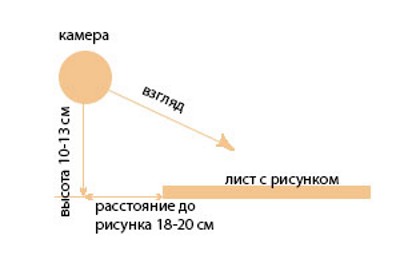
- The light in the process of creating a drawing should correspond to it. If the shadows in the image fall from left to right, the paper should be illuminated from the left side. This will make it easier to understand where the highlights will be and where the shadow will be.
- Once you have your workspace ready, you can begin. Any drawing starts with a sketch, 3D is no exception. It is necessary to consider the object that will be depicted:
- how light and shadow fall on it,
- what are the characteristic features,
- how the outlines change when the angle changes,
- what simple shapes (cube, cone, sphere) do its parts resemble?
- First, draw the main details of the drawing. After that, you can start shading to reflect the light and shadow.
- It is important to break the process into small stages. After completing each, check how the drawing looks from the angle chosen at the beginning of the work. It is easier to erase a dozen extra or incorrect lines than to look for an error and ways to correct it after completing the work.
What you will need
To draw, in addition to a table, hands and inspiration, you need:
- Thick light paper and something to secure it to the table - weights, push pins, tape, a clipboard with clothespins.
- Graphite pencils (hard and soft), simple and colored, markers.
- Eraser or kneaded eraser.
- Ruler.
- Desk lamp.
Creating a sketch of a drawing
A preliminary sketch is equally important for any image, be it a comic or a decorative panel. The main task of the sketch is to outline the basis of the future work and determine the position of the figures.
For the sketch, it is better to use light strokes with a hard pencil (T or H), so that they can be easily erased if necessary. At this stage, you need to draw the main lines that outline the boundaries of the main elements of the drawing and give them a predetermined shape. After this, you can begin to apply hatching to convey light and shadow.
How to convey light and shadow correctly
Logical rendering of shadows is the key to the realistic depiction of a three-dimensional object. The closer the light source, the lighter the surfaces of objects and vice versa, also the darkening of individual parts of the object changes significantly depending on the shape.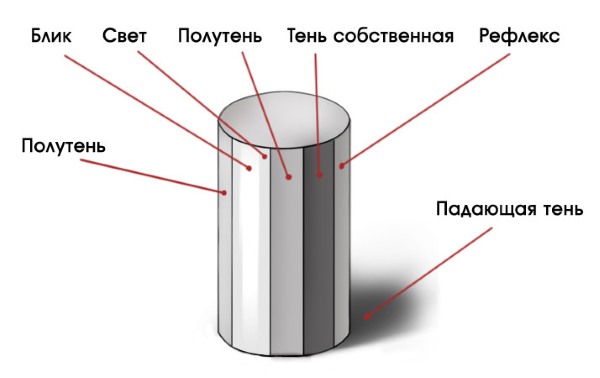
For example, a cube illuminated from the left will have a light left side and a gradually darkening right side. In this case, the border of the transition from light to shadow will be similar to a straight line parallel to the left edge of the figure. If you replace the cube with a sphere, the edge of the shadow will take the form of a semicircle.
Recommendations:
- Carefully study the object before creating its three-dimensional image, determine its features.
- Apply hatching lines in accordance with the shape of objects and the intended lighting.
- Apply shadows little by little, consistently. Increase the darkening carefully, as it is much easier to apply additional shadow later than to remove the existing one.
- There is no need to make clear boundaries in dark places; it is better to blend them with a special shading tool or just a piece of paper until you get a single smooth shade.
- You can use the eraser to further lighten elements.
Master classes for beginners
Knowing the theory, you can try to create your own 3D drawings on paper. For beginners, the best practice would be to repeat other people's work. Master classes will help you understand the logic of constructing volumetric images.
3d Hand
To draw a three-dimensional hand, the "ruling" technique is used. This method is ideal for initial attempts at creating 3D illusions on paper.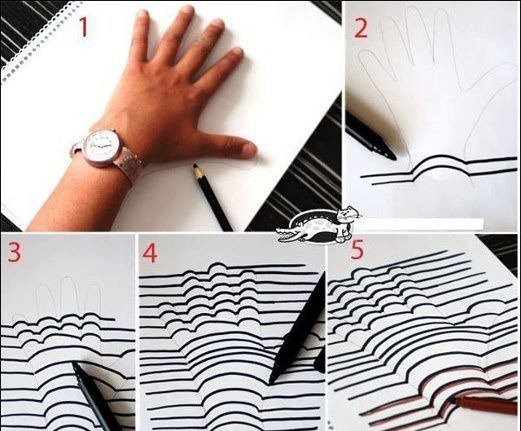
What you need:
- Trace the outline of a palm with fingers spread out on a piece of paper.
- Line the page like a school notebook.
- Leave the lines straight to the right and left of the hand borders.
- “Above” the hand, bend the lines away from you, repeating the convex shape of the back of the palm and fingers.
- Make all the lines brighter, color the resulting “lines” in contrast.
- If desired, you can add a small shadow on one side.
When looking at such a picture, it seems that the sheet lies on top of the voluminous hand, covering it like a thin fabric.
3d Heart
To depict a three-dimensional heart, you will also need a ruler.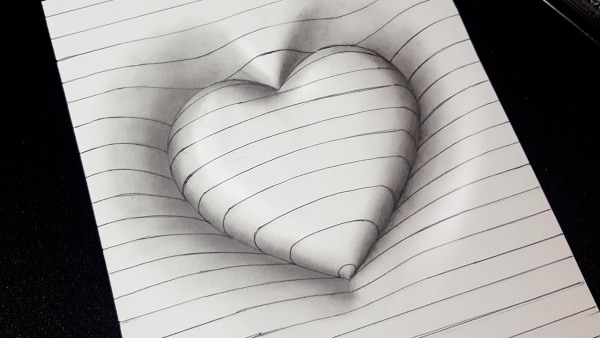
Step by step:
- Draw the outline of a heart in the center.
- Line the entire sheet, excluding the outline of the central image.
- Curve the lines around the image to create the illusion of being "indented".
- Make the lines brighter, and if desired, you can color the “lines”.
- Apply shadows, emphasizing the volume of the heart and the depression in which it lies.
If everything is done correctly, the drawing will look as if a three-dimensional heart is lying on a soft striped pillow.
3d Hole in paper
Contrasting stripes will make the hole drawn in the page look realistic. You will need a pencil and a ruler, since all the lines of the drawing are straight. Draw a rectangle of the correct shape closer to the center of the sheet. If you place the future "hole" end-to-end with the edge of the canvas, the effect will be less noticeable.
Let's draw:
- Connect the straight lower left corner of the figure with the upper right corner.
- Mark lines parallel to two adjacent sides of the rectangle with a crease along the marked diagonal. The result is one large rectangle with several small ones, as if nested inside each other.
- Make the auxiliary diagonal brighter. The image resembles the view of the inner corner of an open box, striped from the inside.
- Paint the stripes one by one, starting with the smallest area in the corner of the figure.
- Decide where the light source will be. Apply a light shadow to the light stripes from the corner of the crease to the edge of the drawing, reducing the length of the darkening from the "bottom" to the "top".
- Blend the shadows. The drawing is ready.
3d Hole in the ground
As always, you should start with a sketch of the future hole. The more bends, the more interesting the result looks.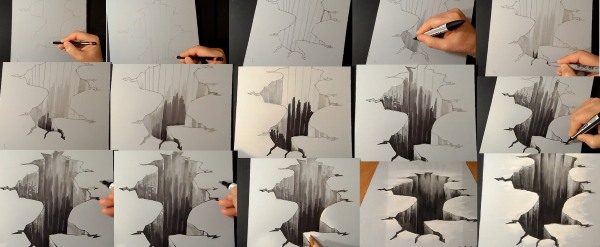
Let's draw:
- The outline must be extended, since the angle of perception of the illusion is about 30 degrees, visually the image will look at least a quarter shorter than the real one.
- Draw lines from top to bottom along the entire contour of the hole, outlining the internal “folds” in accordance with the shape of the hole.
- Draw all the lines brighter, eliminating any possible flaws along the way.
- Choose where the light will fall from and apply a shadow to the “inner” surface of the hole accordingly, emphasizing the roundness of the vertical creases.
- Taking into account the expected lighting, darken the drawing diagonally from bottom to top, from a solid shadow at the bottom to a slight “twilight” at the surface.
- If desired, you can draw the texture of the ground around the hole, add cracks, stones and grass.
You should look at the finished drawing at an angle, along the inner folds, with the dark “lower” part closer to the viewer.
3d Steps (stairs)
Stairs are a great subject for volumetric images.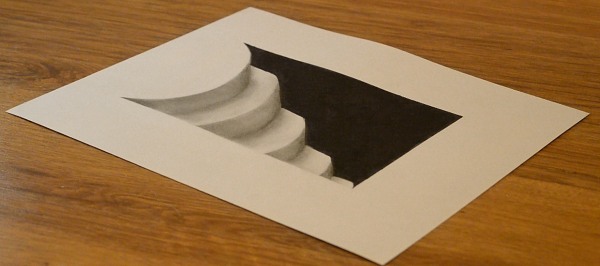
Let's draw:
- Draw a rectangle in the center of the page. This is the opening into which the steps will descend.
- Mark a point in the middle of the right side.
- Connect the left upper corner of the rectangle with the mark using an auxiliary line. This is the conditional edge of the stairs.
- Apply vertical parallels from the bottom edge to the auxiliary line. The stripes should differ in width. The end side of the steps is narrower than the top.
- Now you can form the stairs. To do this, close the wide strips with sections parallel to the bottom edge of the main frame from the auxiliary line. Close the narrow strips at an angle to create a broken edge.
- It is easy to shade narrow stripes.
- Paint the upper part of the drawing from the edge of the steps to the upper and right borders of the opening completely. This part depicts the unlit surface of the wall.
- Mark a point on the right side of the figure approximately ¼ of the way from the bottom edge and connect it with an auxiliary line to the upper left corner.
- Darken a part of the steps from the new line to the unlit surface slightly. Apply thicker shadows closer to the wall.
- Blend the edges of the shadows so that there are no clear lines.
How to draw a water drop 3D
You will need pencils, white paper, and skillful hands.
You can draw a drop as shown in the video:
https://www.youtube.com/watch?v=Up0sLULnF9Y
- First a sketch.
- Details of the drop drawing (shimmer, reflection of light, shadow, trace of water).
3d Doorway (or dungeon)
To create the illusion of a vertical image of the opening, you can add walls and a floor:
- Unfold the sheet wide side. In the lower right part, draw a rectangular part approximately one third of the entire area. Connect the upper left corners of the page and the rectangle. This diagonal is the joint of the walls, the rectangle is the floor.
- The walls are finely lined parallel to the edges of the sheet. The left part of the diagonal is vertical, the right part is horizontal. The walls are ready.
- Draw a doorway with a rounded top in the left wall, almost in the corner, so that the threshold falls at the junction of the wall and the floor.
- The angle between the walls and the floor is the guide for the logical placement of the door. It should be slightly stretched along the left edge so that when viewed at an angle along the diagonal, the proportions are aligned.
- Shade the opening parallel to the threshold, more on the right side.
- Add hinges and a door that opens to the right. The right edge of the door should be parallel to the joint of the walls.
- Detail the door. The "vertical" boards look good.
- Apply shadows. Be sure to shade the borders of the lines by 2-3 cm around the opening and the door to hide the irregularity of the shapes.
Look at an angle of about 30-45 degrees from the lower right corner of the sheet.
3d Butterfly
One of the secrets of the illusion of volume is the cast shadow. The second is altered proportions. The part of the drawing further from the viewer should stretch along the line of sight.
The wingspan is not important, but for beginners mastering 3D drawings on paper, it is better to choose the profile option in order to draw one wing instead of two.
The initial sketch of the butterfly is proportional, the bottom edge corresponds to the final position. This is where the viewer will see it.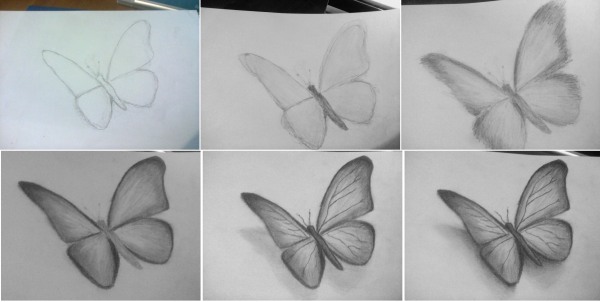
Let's draw:
- Now you need to stretch the picture vertically. To do this, divide the sketch vertically into 4 equal parts. You can draw temporary auxiliary lines in these places.
- The proportions of the bottom piece do not change. You need to stretch the picture starting from the second part - lengthen it by a quarter, the third - by half, and the fourth should be three quarters longer than the original.
- Draw the outline of the drawing, remove everything unnecessary - auxiliary lines and remnants of the first sketch.
- Detail the picture, mark the pattern of the wings, the hairs on the body, draw the antennae. If desired, you can also color it.
- Add a shadow symmetrically diagonally from the bottom edge of the drawing. Darken it completely, blend the edges.
- You can enhance the illusion by cutting off the top of the sheet at about ¾ of the drawing level, leaving a piece of the wing protruding beyond the edge of the page.
3d Eraser
An eraser is a small object, its 3D copy on paper can be literally copied from life. First, you need to set up a workplace. Secure the sheet so that it does not move during the drawing process, install a lamp so that the light falls from the left.
Let's draw:
- Place the elastic where it will be drawn. Trace the outline.
- View from the viewer's chosen vantage point. Mark three dots behind the eraser so that they are above its top three corners.
- Remove the eraser. Draw the "upper" contour of the eraser according to the marks. The edges will narrow from the foreground to the background. Erase the auxiliary lines inside the figure.
- Put the eraser back in place, see how the light falls on it. Trace the cast shadow and put the sample aside.
- Darken the edges of the drawn eraser, blend in the right places and enjoy the result.
3d Falling Man
A very simple 3D illusion - a picture of a little man holding onto the edge. The trick is that the character is located on both sides of the sheet at the same time.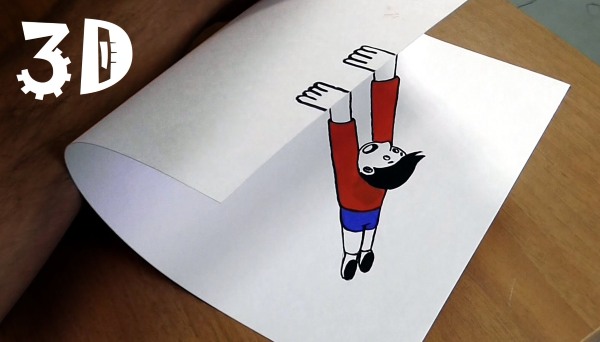
How to draw:
- First, draw a figure of a person reaching up closer to the right edge of the sheet. The upper part of the figure is almost 2 times longer than the lower one, as seen from above. Hands up to the wrists, without palms.
- Measure the distance between the ends of the figurine's arms.
- Turn the paper over with the picture facing down and draw palms with fingers holding the edge of the left side of the sheet approximately in the middle.
- Bend the sheet into a semicircle so that the pictures match. If everything works out, work out the details and color the little man.
How to draw in 2 planes
3D pictures executed in two planes are very effective. The illusion of volume is manifested by distorting the image at an angle to the sheet fold line and changing the proportions.
3d Stairs
You will need fairly stiff paper or thin cardboard.
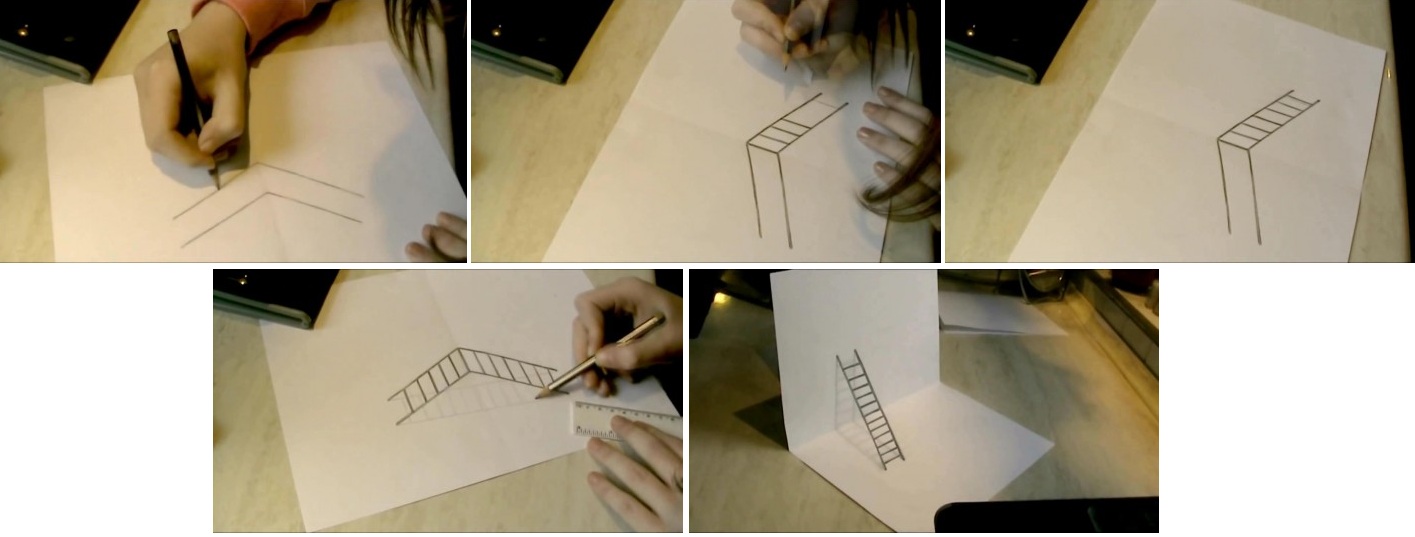
Step by step:
- Before starting work, it is necessary to mark where the fold will be.
- Draw a ladder with rungs on both sides of this line at an angle, mirrored.
- Connect the ends of the ladder with straight lines, repeat the crossbars between them - this will be the shadow.
- The stairs should be brighter than the shadow!
- Bend the sheet and find a viewing angle at which the stairs will appear level. The shadow will remain on the "wall" and "floor".
Volumetric house
Step by step:
- Fold the sheet and mark the fold with a dotted line.
- Draw two perpendicular lines across the fold towards you. The horizontal line is slightly longer – this is the edge of the wall where the window will be, the vertical line will be divided into two parts when bending the sheet, with the lower part becoming the foundation, the threshold will be located on it, and the upper part will turn into the edge of the wall with the door.
- From the resulting right angle draw a line upwards, at an angle of 35-45 degrees, not reaching the bend by about a third of the height. Construct a parallel segment from the right extreme point of the horizontal line. Two corners of the house are marked.
- Next, draw the wall with the window, taking into account the changed proportions.
- When the paper bends, part of the image will disappear from view. Therefore, the door at the end of the house should be drawn with a bend. The larger part is located below the bend, the left part is almost twice as short as the right one.
- From the fold line, continue the doorway with a deviation to the left at almost a right angle.
- Finish drawing the roof. The angle between the roof and the nearest edge of the house is about 160-170 degrees, the roof almost continues the wall. Also mark the end of the roof above the bend. Connect it to the lower part. At this stage, it has the shape of a trapezoid, the lower corner of which is at the place where the sheet bends.
- Add a window, its contours correspond to the borders of the wall.
- Darken the right third of the opening. On the left, draw a slightly open door, taking into account the distortions.
- Fold the page, find the viewing angle at which the roof looks triangular. Apply light and shadow, mark the details.
- Add a shadow from the house.
Toothy mouth
Step by step:
- The biting mouth is drawn on one (vertical) half of the sheet. The drawing is stretched along the fold line and from bottom to top.
- The teeth hold a straight object, such as a pencil.
- On the horizontal part, you should draw the shadow cast by the object holding the mouth.
The cartoon man won't let me fold the paper
Step by step:
- Mark the fold line.
- Draw a line to the fold at an angle of approximately 30 degrees. Repeat in mirror image on the second half of the sheet.
- This is the length of the future human figure and the guide for the drawing. The segments are not equal, the fold will not divide the human proportionally. The lower part is from the legs almost to the armpits, the upper part is the head, shoulders and arms, "resting" on the sheet.
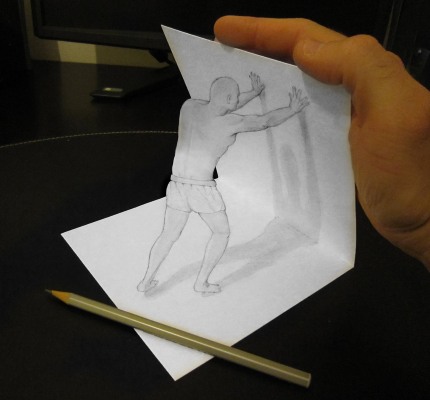
- Sketch a figure of a person, stretching the lower part more than the top - when looking at an angle, part of the drawing is lost from the horizontal surface.
- Fold the sheet of paper and check if the parts match.
- Work on the details, darken the drawing in the right places. Draw the shadow from the arms to the legs.
Crawling snake
Step by step:
- Divide the sheet in the middle with a dotted line, along which it will be folded later.
- Draw a line from the middle of the future vertical surface to the fold line at an angle of 30 degrees. Extend it in a mirror image almost to the edge of the second half of the sheet.
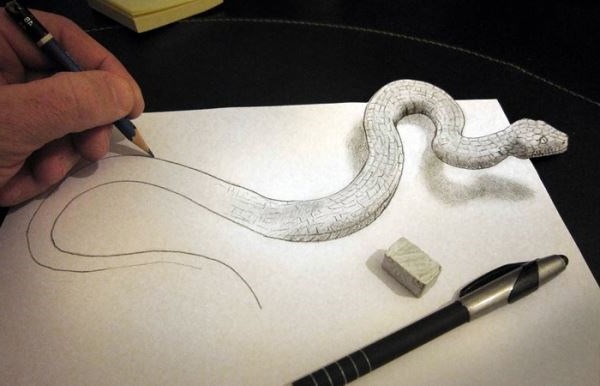
- Sketch a snake along the line. Around the smaller part, draw torn edges of the sheet, as if it had broken out of it.
- Fold the paper along the fold line and check if the pieces match.
- Draw details, apply shadow.
Secrets of 3D Drawing for Beginners
Scroll:
- In order to correctly calculate image distortions taking into account perspective and angle during the process of creating a drawing with a 3D effect, beginning artists are recommended to apply a guide grid to the paper.
- For a successful 3D photo, the light source in the picture must match the real lighting.
- Through the camera, anamorphoses look more impressive than in real life.
- It's best to start with simple shapes like a cube, cone, and sphere. It's hard to create a realistic volumetric drawing without understanding how shadows fall on these shapes.
To start mastering 3D drawing on paper, you need desire, patience and time, and ideas can be gleaned from great artists and just enthusiasts who post their works on thematic sites on the Internet. Studying this technique will allow you to create interesting pictures and postcards with unexpected content to the delight of the author and his loved ones.
Video: 3D Drawings on Paper for Beginners
3D drawings for beginners, watch the video tutorial:
How to draw a 3D picture by cells, watch the video:

Thank you
🙂 Sorry, my hand didn't work out.
nothing to worry about
nothing to worry about
JUST CALL ME POLINA
HELLO
I'M NEW
Me too
HELLO 😀
super! I almost got everything right
the stairs didn't work out
I did it! 😀 🙂
It's easy, I did it all
😀
🙂 My staircase turned out great, but after watching another video I’ll see how it will be if I look at your sketch!!!
Thank you =)
nooooo I couldn't draw the stairs
VERY GOOD 3d DRAWING AND VERY EASY